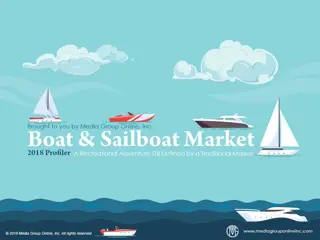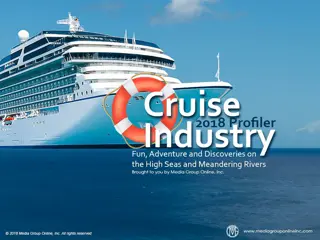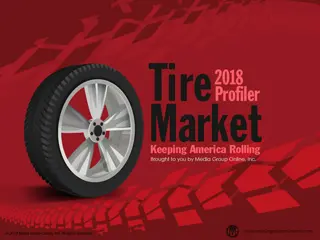RV Industry Trends and Challenges: Analysis for 2017-2019
The RV industry faced challenges in 2018 and is projected to experience a decline in shipments in 2019 due to factors like higher gas prices, interest rates, and trade tariffs. Online research is becoming more prevalent among RV buyers, and manufacturers are adapting to a younger market by introducing new features. Despite optimism from lenders, dealers are dealing with excess inventory, affecting sales. A shift towards a younger demographic and increased online research are key trends shaping the industry.
Download Presentation

Please find below an Image/Link to download the presentation.
The content on the website is provided AS IS for your information and personal use only. It may not be sold, licensed, or shared on other websites without obtaining consent from the author.If you encounter any issues during the download, it is possible that the publisher has removed the file from their server.
You are allowed to download the files provided on this website for personal or commercial use, subject to the condition that they are used lawfully. All files are the property of their respective owners.
The content on the website is provided AS IS for your information and personal use only. It may not be sold, licensed, or shared on other websites without obtaining consent from the author.
E N D
Presentation Transcript
Sales Encounter a Speed Bump After 2017 s wholesale RV shipments totaled 504,600, the 8thconsecutive year of increases, the latest projection for total 2018 wholesale shipments is 479,000, which would be a 5.1% decrease from 2017. The industry was doing well through June 2018, or a total of 271,588 shipments, a 5.9% increase from the same 2017 period; however, since June, the industry has recorded negative numbers, or -2.8% through November, a total of 455,309 units. A number of factors has contributed to a negative year: higher gas prices, increasing interest rates and trade tariffs. Plus, more new units were built and shipped based on the previous record year, which resulted in considerably more unsold inventory.
2019 Shipments to Remain in the Slow Lane The RV Industry Association (RVIA) reports total 2019 RV shipments are estimated at 453,200 units, which would be 5.4% fewer than the projected total 2018 shipments, although the 2019 total could reach 466,000, which would still be a 2.8% decrease. The factors cited above as well as others will certainly impact 2019 s performance, plus manufacturers are facing higher costs, dealers inventory carrying costs are likely to increase and the transition from older to younger RV purchasers are slowing sales. Although lenders for both dealer floorplans and consumer purchases are generally optimistic about the RV industry for 2019, they also realize many dealers are carrying more inventory than during previous years.
More of the Purchase Process Moves Online Multiple surveys from RV Trader during 2017 and 2018 indicated the largest percentage, or 33.6%, of potential RV buyers were conducting their initial research on the Internet, which is similar to the current purchase funnel for light-vehicles. Traditionally, RV customers visited a dealership, spent considerable time there and expected salespeople to provide them with comparable information. Today, the largest percentage, or 36.5%, of customers are researching RVs a year or more before buying. Again, much like today s light-vehicle buyers, the largest percentage, or 43.2%, of potential RV buyers said offering the lowest price was how they decided from which dealer to buy an RV, with a reputation for excellent service a distant second, at 18.9%.
Adjusting to a Younger Market According to Statistical Surveys, which specializes in RV industry data, 49.78%, or essentially half of all new RV buyers during 2017, were 54 years of age or younger, compared to 45.98% during 2015. The RV Trader survey data cited on page 2 of the Profiler also revealed 40% of those participating in the surveys said they had never owned an RV, which is not typically the case with the much older demographic of RV owners. On display at the January 2019 Colorado RV Adventure & Travel Show were models with solar panels, USB ports and Wi-Fi signal boosters, all obvious features/amenities targeting younger RV buyers.
New Features for a New Generation of Buyers As more young and middle-aged adults buy RVs, there is increasing interest in and sale of park-model RVs, which are typically a cabin-like structure installed at a RV or camping facility. Many RVers want to avoid towing an RV and hooking it to utilities. According to the RV Trader survey data on page 2 of the Profiler, 59.4% of respondents to its surveys have children. This has led many manufacturers to build bunkhouse models to accommodate families in both large motorhomes and more-affordable towable units. The RV aftermarket is also changing, as an RVIA 2018 survey found younger RV owners made more than 12 parts and accessories purchases during the past 2 years, compared to the average RV owner s 6 purchases.
Camping in Comfort From 2014 to 2017, there was a 20% increase in camper households that camped at least once a year, or 6.5 million, and a 64% increase of those that camped 3 or more times per year, or 11 million. According to Kampgrounds of America s 2018 North American Camping Report, almost as many members of younger generations than Baby Boomers said they would like to become full-time RVers: Baby Boomers, 18% and Millennials and Gen Xers, 16% each. Larger percentages of Millennials and Gen Xers said they were very likely to consider renting an RV from a peer-to- peer service, at 21% and 23%, respectively, compared to Baby Boomers, at 18%.
Advertising Strategies As the RV/Camper audience becomes younger, TV is still a viable ad medium, especially to reach families, but a healthy portion of commercial content should drive/invite viewers to dealers Websites and social media pages. Because RVing is becoming more of a family-with-kids activity, dealers should consider a contest for a free weekend use of an appropriate RV, such as a bunkhouse motorhome model, at a local camp grounds. With a significant percentage of younger adults expressing interest in RV rentals, dealers may want to offer a special weekend rental package that includes a free basket of food and beverage items. A rental program may also help with moving excess inventory.
New Media Strategies Ask recent customers who purchased a park-model RV to share their stories with a series of short videos explaining how they decided on that model, where they had it installed and why they chose that location, which then become Website and social media content. Since so many younger RV owners purchase many more parts and accessories than the average owner, dealers can create an online showcase/catalog on their Websites and also post announcements of new parts and accessories on their social media pages. As more of the RV purchase funnel moves to the Internet, dealers can use their Website and social media platforms to post photos and videos to answer some of the most-asked questions about the RVing lifestyle for all ages, how to hookup to utilities, maintenance, etc.























